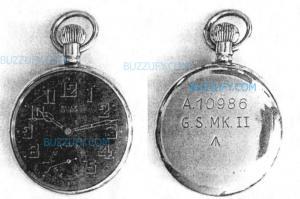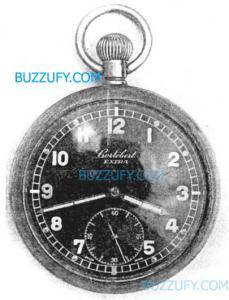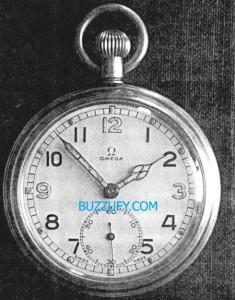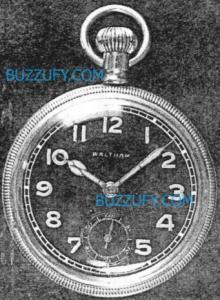Military wristwatches are believed to have received their name from a German military request for a soldier in a watch house, otherwise known as a guard tower. One story tells that the military wristwatches came into use when a German naval officer needed to know the time but could not pull out a pocket watch since both his hands were busy operating the machine. Another story is that Wilhelm I placed an order at a Berlin trade show. These new wrist watches saw their first action in the Boer War. Later seen in World War I, rudimentary wrist watches were small sized pocket watches with metal lugs soldered on so that a fabric strap could hold the watch to a wrist. Some had no cover over the watch crystal, while others had a metal cover, some of these had pieces of the cover cut, so that the watch could be seen without opening the cover.
Why were most watches produced during WWII, including the A-11, smaller than most eras? It was the fact that materials were limited. Iron, Steel, Aluminum, Copper, Rubber, Brass, Oils and other strategic metals, compounds and supplies were scarce. This included Europe, Asia and South America.. The Swiss followed suit. Only cases made prior to WWII and still in inventory were produced. But even that was limited by the needs of Germany, Italy and Russia. The Swiss as neutrals did business with all of the countries at war or not.
Top brands watches on WWII: Alpina, Arsa, Buren, Bruchsicher, BWC, Choisi, Civitas, Domino, Edo, Freco, Gala, Girard-Perregaux, Glycine, Grana, Hanhart, Helbro, Helios, Helma, Helvetia, Junghans, Longeau, Longines, Mimo, Minerva, Moeris, Moser, Mulco, Nisus, Phenix, Record, Recta, Revue, Stabila, Titus, Zenith, General Watch&Co, Grana, Hado, Förster Pforzheim, Gustonia, Flora, Acacia, Bulla, Era, Onda, Onsa, Alpina, Siegerin, Pronto, Monitor, Stowa, Tritona, Wagner, Aeschbach, Para, Berg, Nila, Omega, Mimo, Natalia, Wempe, Geering, Bidlingmaier, Speck, Vogele, Wiemer, Tutima, Hanhart, Zentra, Selza, Aristo, Lemania, Titus, Breitling, IWC, Roamer,Record, Rellum
Military Pocket Watches:
he British armed forces were slow to embrace change, and consequently, when war loomed once more in 1939, the War Department was caught ill-prepared. Pocket watches were hurriedly purchased by the procurement office from numerous Swiss makers and from commercial retailers, in anticipation of the shortages that were likely to follow. Most of these pocket watches were regarded as “General Service” timepieces and classified as “Temporary Pattern”. While more appropriate watches were not yet available to the Army in sufficient numbers these “GSTP” pocket watches had to suffice, becoming the workhorses of the Army’s horological instruments. “General Service” watches were exactly that. They fulfilled the role of the contemporary timekeeper for routine duties such as those perfomed, for example, by radio operators and drivers. Each Swiss-produced GSTP watch had a 15 jewel movement, luminous black or white dial and subsidiary seconds dial. Cases were normally provided with snap backs, although some do have screw backs. This particular Leonidas pocket watch is a typical example of the standard British Army GSTP.
Military Rolex pocket watches were available, circa 1939, in two styles, with either a black luminous or a white non-luminous dial. The black dial pocket watch was evaluated by the British Army and given the grade “General Service Mark II”. The white dial version was not intended for pocket use, and was constructed in a case without a chain bow. This was so that the watch could be inserted in a receptacle within a protective wooden case, or on a vehicle instrument panel. The second pattern was designated by the Army as a “B” type, or “back-up” timepiece to a chronometer watch. The “B” mark used to prefix the issue number of the watch was stamped on the rear of the screw back and on the side of the casing. The GS Mk.II watch had all the issue numbers prefixed with the letter “A”. The movements of both models are signed by Rolex on the dial case and movement, which is also marked “15 Rubis”. These Rolex movements are actually manufactured as ebauches by the Cortebert watch company, based on Cortebert’s caliber 526 movement.
This Cortebert “Extra” pocket watch, designated as a General Service Timepiece, is housed in a soft alloy screw-back case; this example is marked on the back with the broad arrow, “G.S.T.P.”, and “T7905”. Made by Cortebert circa 1942, the signed caliber 526 movement is also marked “15 Rubies”. This movement bears a striking resemblance to the Rolex military pocket watch movement – unsurprisingly, as Cortbert supplied ebauches to Rolex based on the caliber 526 movement. Although superficially the connecting bridge work follows a different layout, all the working parts are interchangeable between the two models.
This 15 jewel British Army issue General Service Timepiece, circa 1939, has survived in pristine condition, with the white enamel dial retaining all its original luminous paint, This scarce example was supplied by the renowned maker Omega, whose name and trademark appear on the dial. Omega were first contracted by the British during the First World War, when they supplied motor vehicle clocks for Army trucks. However, between 1939 and 1945 the British were supplied with huge quantities of Omega watches which totaled over 100,000 pieces. These represented over half the total number of timepieces procured by the British armed forces during the war. After the Allied victory Field Marshal Montgomery visited the Biel factory and personally thanked the staff at Omega for their work towards the war effort.
Royal Air Force issue pocket watches differ from the Army’s GSTPs only in being non-luminous. 15 jewel pocket watches were often chosen by navigators in preference to wristwatches, especially during night bombing operations. The navigators found it useful to place their pocket watches on the carts from which they were working, and the watch’s size meant that the time could be read more easily. On this fine Jeager Le Coultre watch note the size of the subsidiary seconds dial; much larger than the confugaration on a normal watch dial, it emphasizes the importance of elapsing seconds in certain operational circumstances, The back of this case is marked “6E/50”, “A1027C” below the broad arrow.
Waltham produced two field grade US Army Ordnance pocket watches during the Second World War, the Model 1609 with 9 jewels and the Model 1617 with 17 jewels. Basically they were the same watch, employing the 16 size movement. Early examples, circa 1941, have white dials, and cost $12.50 for the Model 1609 and $24.70 for the model 1617. By 1944, when the first batches of the Model 1609 arrived in England, a black luminous dial was also being used. These were primarily for issue to the Royal Navy, as with this example, which is marked on the back of the screw case with a small broad arrow. Unusually, however, some Waltham Model 1609 pocket watches were issued to the Army.












